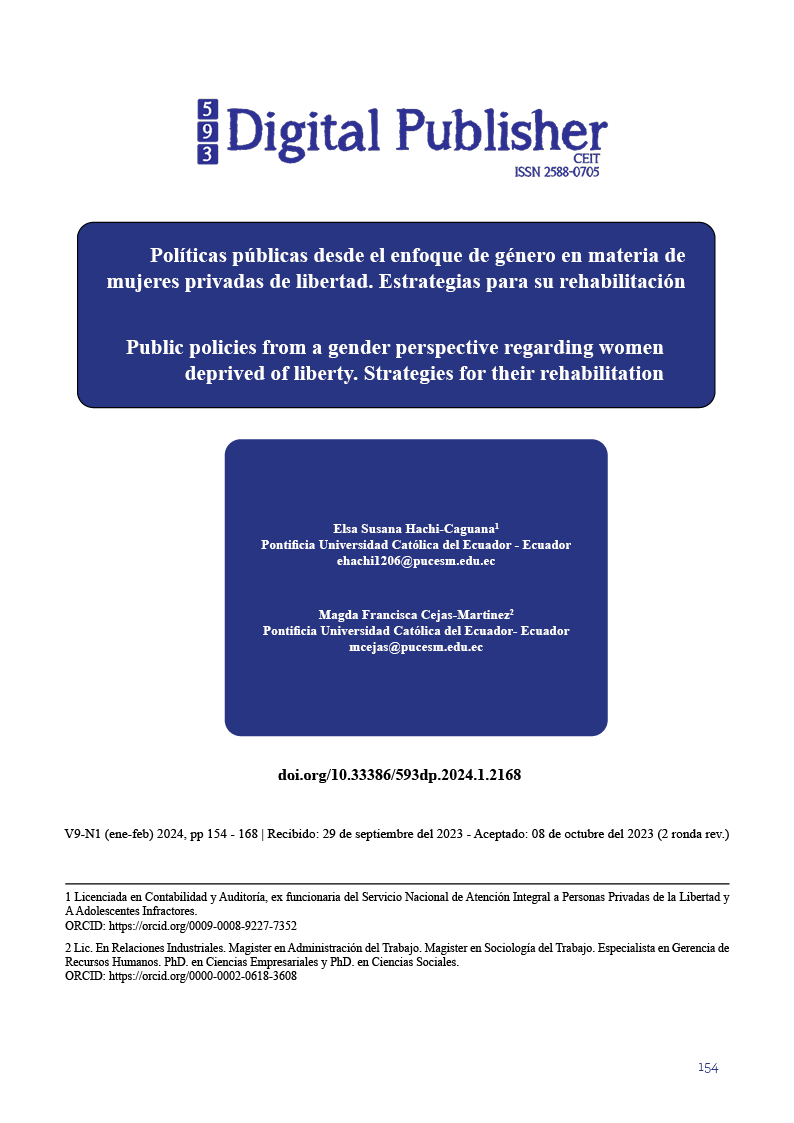Public policies from a gender perspective regarding women deprived of liberty. Strategies for their rehabilitation
Main Article Content
Abstract
The article "Políticas públicas desde el enfoque de género en materia de mujeres privadas de libertad. Strategies for their rehabilitation" mentions the preponderance that public policies have on the needs of women with an emphasis on the Pastaza N.1 Mixed Provisional Detention Centre. The objective was to analyse current public policies aimed at women prisoners from a gender perspective, identifying strategies that promote a comprehensive, respectful, and equitable rehabilitation. The research was developed with a mixed approach, for which it was necessary to review specialised documented sources, considering both quantitative and qualitative research. The field research was generated through the application of a survey at the Centro de privación provisional de la libertad Mixto Pastaza N.1, the qualitative research was developed through hermeneutics. This research was able to identify those conditions that hinge on the prison environment for the design of rehabilitation programmes that reflect the specific needs of women, such as mental health and life skills, the creation of a safe and supportive prison environment, and the provision of ongoing services aimed at strengthening skills and competencies upon release, among other key aspects. As a contribution of this research, it will emphasize the results that a gendered approach to rehabilitation can lead to more effective and humane strategies, underlining the importance of women's experiences in these policies.
Downloads
Article Details

This work is licensed under a Creative Commons Attribution-NonCommercial-ShareAlike 4.0 International License.
1. Derechos de autor
Las obras que se publican en 593 Digital Publisher CEIT están sujetas a los siguientes términos:
1.1. 593 Digital Publisher CEIT, conserva los derechos patrimoniales (copyright) de las obras publicadas, favorece y permite la reutilización de las mismas bajo la licencia Licencia Creative Commons 4.0 de Reconocimiento-NoComercial-CompartirIgual 4.0, por lo cual se pueden copiar, usar, difundir, transmitir y exponer públicamente, siempre que:
1.1.a. Se cite la autoría y fuente original de su publicación (revista, editorial, URL).
1.1.b. No se usen para fines comerciales u onerosos.
1.1.c. Se mencione la existencia y especificaciones de esta licencia de uso.
References
Alexander, M. (2010). The New Jim Crow: Mass Incarceration in the Age of Colorblindness. The New Press.
Amnesty International. (2021). Global Report on Prisons and Human Rights. https://www.amnesty.org/
Benavente y Valdés (2019). Políticas Públicas desde el enfoque de género. Santiago de Chile.
Bosworth, M. (2019). Gender and Penal Policy. En J. Simon & R. Sparks (Eds.), The Sage Handbook of Criminological Theory (pp. 542-561). Sage.
Butler, J. (1990). Gender Trouble: Feminism and the Subversion of Identity. New York: Routledge.
CIDH-Ecuador. (2011). Informe sobre la situación de los derechos humanos en Ecuador. Organización de los Estados Americanos. https://www.oas.org/en/iachr/docs/pdf/ecuador2011eng.pdf
Clear, T. R., & Frost, N. A. (2014). The Punishment Imperative: The Rise and Failure of Mass Incarceration in America. NYU Press.
Constitución de la República del Ecuador. (2008). Decreto Legislativo 0 Regis-tro Oficial 449 de 20-oct-2008 Ultima modificación: 13-jul-2011 Estado: Vigente. https://www.oas.org/juridico/pdfs/mesicic4_ecu_const.pdf
Daly, K., & Proietti-Scifoni, G. (2011). Reparation and Restoration. En M. Tonry (Ed.), The Oxford Handbook of Crime and Criminal Justice (pp. 207-253). Oxford University Press.
Fazel, S., & Seewald, K. (2012). Severe mental illness in 33,588 prisoners worldwide: Systematic review and meta-regression analysis. British Journal of Psychiatry, 200(5), 364-373. https://doi.org/10.1192/bjp.bp.111.096370
Hannah-Moffat, K. (2001). Punishment in Disguise: Penal Governance and Federal Imprisonment of Women in Canada. University of Toronto Press.
Human Rights Watch. (2020). World Report 2020: Rights Trends in Prisons. https://www.hrw.org/world-report/2020
Lasluisa R, Diego J. (2021).Política pública penitenciaria y los derechos del buen vivir https://repositorio.uta.edu.ec/bitstream/123456789/33747/1/BJCS-DE-1167.pdf
Lobelle F. (2017)Políticas públicas sociales: apuntes y reflexiones Public Poli-cies: notes and reflections. ARCIC vol.6 no.14 La Habana set.-dic. 2017.http://scielo.sld.cu/scielo.php?script=sci_arttext&pid=S2411-99702017000300006
Open Society Foundations. (2014). Presumption of Guilt: The Global Overuse of Pretrial Detention. https://www.opensocietyfoundations.org/publications/presumption-guilt
Organización de las Naciones Unidas (2018). La rehabilitación de las mujeres privadas de libertad. Nueva York: Naciones Unidas.
Organización de los Estados Americanos (OEA) Personas Privadas de la Liber-tad en ecuador, CIDH-2011 https://www.oas.org/es/cidh/docs/anual/2011/indice.asp
Organización Mundial de la Salud (OMS). (2015). Salud reproductiva.http/oms.org.eu
Sagnay-Ochoa, R. (2022). Derechos de los hijos de mujeres privadas de libertad del centro de rehabilitación social Zaruma. 593 Digital Publisher CEIT.
Sistema Nacional de Atención Integral a Personas Privadas de Libertad (SNAI) (2020). Reglamento del sistema nacional de rehabilitación social https://www.atencionintegral.gob.ec/wp content/uploads/2020/08/Reglamento-del- SIstema-de-Rehabilitacio%CC%81n-Social-SNAI-2020_compressed.pdf
Transparency International. (2017). Global Corruption Barometer: People and Corruption: Europe and Central Asia 2016. https://www.transparency.org/
Travis, J., Western, B., & Redburn, F. S. (Eds.). (2014). The Growth of Incarceration in the United States: Exploring Causes and Consequences. National Academies Press. https://doi.org/10.17226/18613
Travis, J., Western, B., & Redburn, F. S. (Eds.). (2014). The Growth of Incarceration in the United States: Exploring Causes and Consequences. National Academies Press. https://doi.org/10.17226/18613
Walmsley, R. (2018). World Prison Population List. Institute for Criminal Policy Research. https://www.prisonstudies.org/sites/default/files/resources/downloads/world_prison_population_list_12th_edition_0.pdf
Walmsley, R. (2018). World Prison Population List. Institute for Criminal Policy Research. https://www.prisonstudies.org/sites/default/files/resources/downloads/world_prison_population_list_12th_edition_0.pdf
Wildeman, C., & Wang, E. A. (2017). Mass Incarceration, Public Health, and Widening Inequality in the USA. The Lancet, 389(10077), 1464-1474. https://doi.org/10.1016/S0140-6736(17)30259-3



